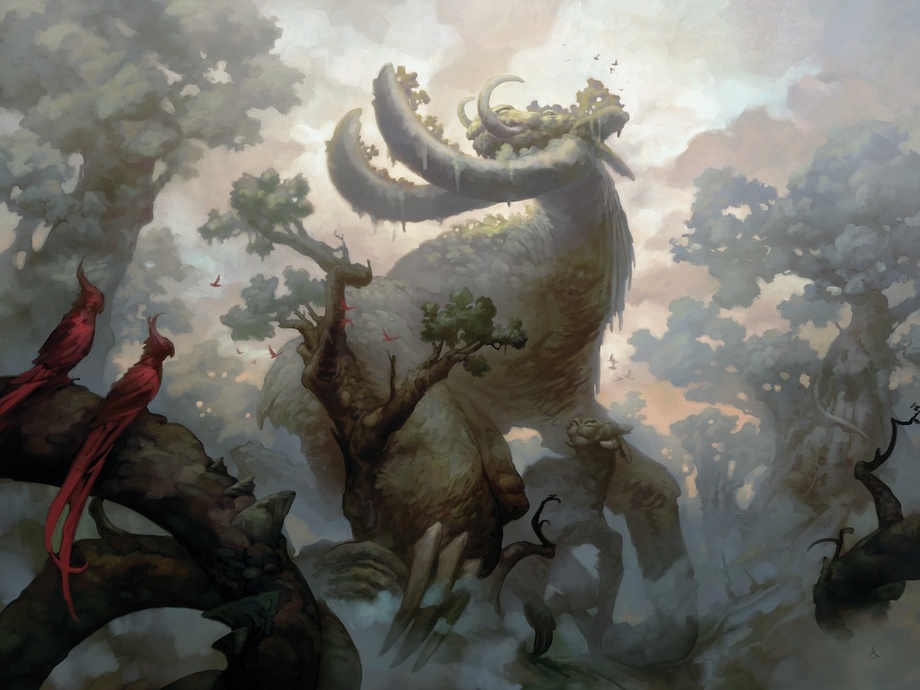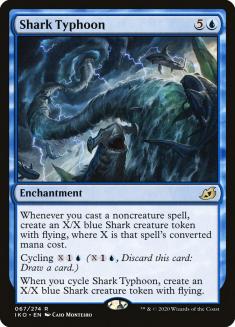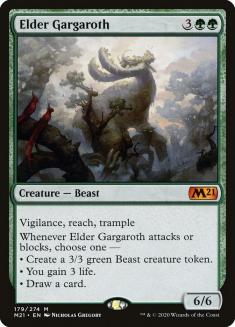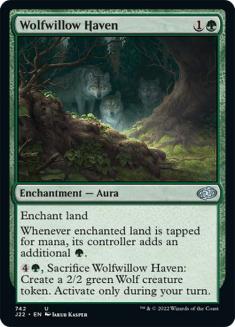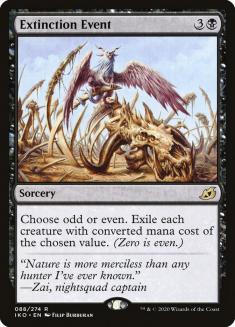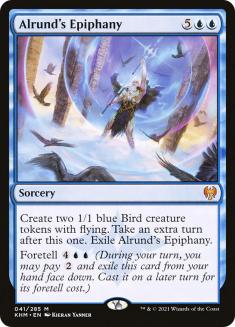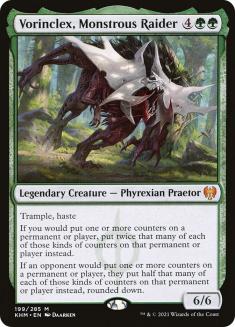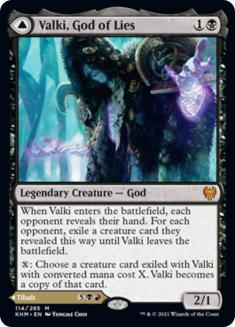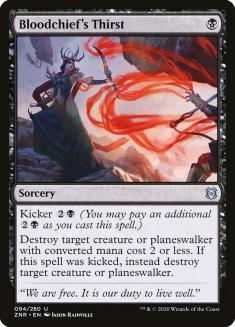My article this week will focus on updating Sultai Ramp (Yorion) for the current Standard metagame. Last week’s article was the introduction to the archetype, explaining my card choices and giving y’all a functional sideboard guide including as much information as I could jam into it. This week, we’re going to focus on the changes to the format and how we can adapt to defend against these new aggro bros. It’s been a while since I’ve felt the need to write about the same deck for two weeks in a row, but I’m really feeling Emergent Ultimatum. With multiple decks popping up out of nowhere, and Mono-White Aggro❄ taking first AND second in the SCG Tour $5K Kaldheim Championship Qualifier last weekend, there’s plenty of new and pertinent information to share
Before we go any further, here’s the decklist we’ll be working with today.
Creatures (3)
Lands (32)
Spells (45)
- 2 Into the Roil
- 4 Cultivate
- 4 Omen of the Sea
- 3 Wolfwillow Haven
- 1 Kiora Bests the Sea God
- 2 Shark Typhoon
- 3 Extinction Event
- 4 Heartless Act
- 4 Emergent Ultimatum
- 2 Eliminate
- 4 Sea Gate Restoration
- 4 Jwari Disruption
- 2 Shadows' Verdict
- 4 Binding the Old Gods
- 2 Alrund's Epiphany
Sideboard

An Emphasis on Aggro
The last weekend’s SCG Tour Online events generated the confidence for a lot of people to play aggro again. Famous streamer and heel Crokeyz made waves with Mono-Red Aggro, taking his list to a 6-0 finish and defeating fellow burn wizard sandydogmtg to qualify and max out on byes for the Sunday Kaldheim Championship Qualifier. In addition to Mono-Red Aggro❄ gaining some momentum in Saturday events, Mono-White Aggro❄ popped up in a few different places and put up some staggering numbers considering the low number of players picking up the archetype.
Two decks, both aggressive, attacking the format on the same weekend has forced my hand. We have to be more reactive. We have to be more interactive. But we also need the right types of interaction. More removal means more dead cards in some matchups, but it also means our aggro matchup gets a little better.
When building a midrange strategy, balancing your threats and answers to fight the expected metagame is one of the most important aspects of deckbuilding. If you play too many removal spells, you’ll find yourself losing the battle to the mirror and control. If you have too many threats, chances are they’ll gum up your hand and ultimately lead to losing to aggro. Finding cards that split the difference is what makes or breaks an archetype. Any spell that’s excellent against all polarities, or serviceable against some while being stellar against another, should be a focal point in deckbuilding.
I’ve gotten a lot of guff for only playing two copies of Shark Typhoon in the maindeck. Let me be clear: Shark Typhoon is very bad against aggressive decks. I know that might sound weird, but Shark Typhoon just doesn’t cut it against an opponent trying to hit you with Lovestruck Beast and the like. It’s mostly a chump blocker but can occasionally trade for a small creature in a pinch. The problem is that it’s relatively expensive to cycle before it does much of anything. The overall benefit of playing Shark Typhoon is that it doubles as removal against opposing creatures and a threat against other controlling strategies. It’s one of those split cards that are fine in two different types of matchups. So why aren’t we playing four?
The secret is that I am playing four. In competitive Magic, building your entire deck and sideboard to mesh well together is a huge deal. I also recognize that overloading on threats is not in our best interest, and also that Shark Typhoon is inefficient as an answer. It’s a placeholder against aggro and pretty good or great against control, even in the face of them having a bunch of spot removal. It forces their hand, and forces the action. What happens after a Shark Typhoon is often that your opponent will spend mana in a spot where they can’t afford to, which ultimately makes room for you to resolve one of your game-enders.
Shark Typhoon is also absurd in sideboard games. Most opponents will attack your strategy with cheap counters like Mystical Dispute and Negate. Shark Typhoon gives you a way to punish them for holding up that extra mana. Having four copies after sideboard means you’ll likely draw one early, which is usually fine to cycle, but you can draw another one or two later in the game to put a ton of pressure on the opponent in spots that are awkward for them.
I also want to make one thing crystal clear: I think you should cycle Shark Typhoon aggressively. Unless your hand is all lands, cycling an early Shark Typhoon could help hit land drops, find removal, or just smooth out your draw. Don’t hold onto it too long because it just helps you dig for actual game-enders or interaction. It’s not the focus, but a tool in helping get to the long game while combining nicely with the likes of Alrund’s Epiphany to steal games. You also have the added benefit of getting a few more raw win conditions against attrition matchups. I’ve searched for Shark Typhoon multiple times now off the second or third Emergent Ultimatum because I didn’t have anything left!
When it comes to playing against aggro, my inclination is to sideboard out Shark Typhoon and/or Valki, God of Lies until I have one or zero of them left in my deck. They aren’t equipped to grind through one Emergent Ultimatum, so you don’t really need more threats than that. As long as you keep churning and looking for Emergent Ultimatum while protecting your life total and containing your opponent’s threats, you can side down to a single Kiora Bests the Sea God, Valki, and Vorinclex, Monstrous Raider. Any two of those plus an Alrund’s Epiphany should be enough to close out any game where you’re at parity or ahead. Sometimes it takes a good Emergent Ultimatum plus another few turns of working, but being threat light against creature-heavy strategies is ideal.
My list during Sunday’s event had one Elder Gargaroth maindeck and one in the sideboard. This was a concession to my fear of facing aggro every round. Elder Gargaroth sits in a really nice spot on the curve, hitting on a turn where your opponent usually thinks your shields are down. It’s such a unique threat that’s relatively hard to kill and just so happens to bury any opponent that doesn’t immediately kill it, kill you, or finagle a way around it (like Embercleave). On a dry battlefield, it’s incredible. On a sticky battlefield where your opponent has a ton of attackers and blockers, there’s virtually no way for them to justify blocking with two creatures and attacking into it seems like a losing proposition.
The two in the sideboard of our current list is still a nod to those aggro decks. Giant Killer is a tough answer for us to swallow, but chances are they’ll be siding it out against you. Even if they leave it in, challenging them with a threat is a great way to steal games that might be otherwise unwinnable. Risk versus reward is on full display here, as tapping out for Elder Gargaroth means you’re likely in trouble if your opponent kills it then immediately attacks. That moment of risk becomes realized on the turns where you aren’t spending your mana to kill creatures and your opponent has threats and the right answer. If that all lines up, you’re in trouble. If it doesn’t, Elder Gargaroth is a hard-carry.
Wolfwillow Haven and the Fear of Having Permanents
After playing a few mirror matches, I found myself wanting to make my opponents’ Binding the Old Gods as weak as possible when playing a mirror. Binding the Old Gods being a ramp effect, card advantage spell, and interaction all wrapped into one is ludicrous, offering Sultai Ramp (Yorion) an interactive game piece that will only get better as people play more to the battlefield. It’s an excellent Magic card, and one that you would do well to keep in the back of your mind when playing games, building decks, and understanding complex sequences in games where both players are hitting their lands and spells in stride.
In my first few days of playing the format, someone in my chat brought up how bad it felt to have one of your early permanents hit with a Binding the Old Gods. Ever since then, I’ve tried my best to limit the number of those permanents on my menu. If I can strand a Binding the Old Gods in their hand, I should have an advantage, right? That logic is occasionally dangerous because it ignores the fact that overloading specific or unique removal is often more advantageous than dodging it. It’s a tough line to walk!
Wolfwillow Haven offers a mana advantage for a low cost. The fact that you can put it on an untapped land and generate a mana immediately means it effectively only costs one mana in many instances. It also helps hit your triple green for Emergent Ultimatum. In a pinch, the excess enchantments can be cashed for Wolf tokens. It’s a great Magic card that I’ve found success with across multiple formats. So why don’t I like it much in this archetype?
Well, I do. I love Wolfwillow Haven in Sultai Ramp (Yorion) because of all the reasons listed above. We want to cast Emergent Ultimatum as fast as possible, but it’s far more important to contain what your opponent is doing in the early turns because that directly impacts your life total. In a way, Wolfwillow Haven being so cheap helps you bridge the gap because you get to fit a tapped land into the mix sometimes without it being too detrimental. Since a large portion of our mana base contains lands that often enter the battlefield tapped, having ways to mitigate that drawback is important.
But that theory of nonland permanents being a general net negative against an opposing Binding the Old Gods seems to hold somewhat true. I know it feels like crap to have your Wolfwillow Haven blown up. Having more of those types of targets makes you vulnerable to one of the better removal spells in the format.
A few iterations ago, I worked hard to dodge the card completely outside of our finishers. In the end, Binding the Old Gods was always solid. There was something getting hit on most occasions, so reducing the raw number of permanents just made it all the more glaring when it did work. And it worked in like, every game, because it’s just a great card with a lot of versatility and functionality. Even blowing up an Omen of the Sea makes Yorion much worse, in turn making it much less threatening as a mid-game play. It’s obvious to anyone who’s played a mirror that Binding the Old Gods is excellent in an attrition matchup, so it makes sense to try to mitigate that completely. I just don’t know if it’s worth throwing away equity on powerful early plays like Wolfwillow Haven or the much more contested Mazemind Tome.
Casting an Extinction Event on the third turn is often lights out for an aggro deck full of one-drops. It won’t always be the nail in the coffin that Shadows’ Verdict can be, but being a full mana cheaper and less harsh on color requirements is definitely a plus. With Rakdos Sacrifice losing some luster this past weekend, I could see a huge shift toward Extinction Event as the sweeper of choice in the coming weeks. Obviously those numbers could ebb and flow with the changing tides, but this is where I’m at right now and I’m pretty happy about it. Extinction Event was never “bad,” it was just slightly worse than Shadows’ Verdict for the last few weeks.
I cannot stress enough how powerful this card is. Time Walk effects are rarely this good, but combining it with Emergent Ultimatum makes for some really tough piles. I think there’s a good chance we should be running four copies. The layaway payment plan of foretell is nice, but just casting two or three in a row can steal some games you have no business winning. That’s entirely the point of the card, after all!
Vorinclex is good in enough spots that I might just keep him around as another tutor target for Emergent Ultimatum, but it’s one of the worst draws in the deck and isn’t too necessary in many Emergent Ultimatum piles. I’ve seen a few lists cut it, and I don’t hate that idea. My gut says it’s too important for guaranteeing a second chapter of Kiora Bests the Sea God, but time will tell how important that ends up being as opposed to just running a more efficient list.
Updating the Sideboard Guide
Two decks have picked up in popularity over the last week, so I thought I would add them to the sideboard guide I built last week. Now, the list is a bit different than last time, but knowing what type of cards are weaker in what matchups will help you get better at making sideboard choices on the fly. Once you start using sideboard guides like a suggestion as opposed to gospel, you’ll realize the full potential of understanding a matchup inside and out.
VS Mono-White Aggro❄
Creatures (31)
- 2 Giant Killer
- 4 Alseid of Life's Bounty
- 4 Seasoned Hallowblade
- 4 Selfless Savior
- 1 Legion Angel
- 4 Skyclave Apparition
- 4 Luminarch Aspirant
- 3 Halvar, God of Battle
- 3 Usher of the Fallen
- 2 Reidane, God of the Worthy
Lands (23)
Spells (6)

Out:
In:
After sideboard, ramping is much less relevant because we get to trim some of our more clunky threats for cheap removal. Valki is pretty bad outside of Emergent Ultimatum, though casting one in the first game is certainly fine and should be done regularly to stifle their development onto the battlefield. After sideboard, a single will do nicely. I like keeping the Vorinclex because it allows for more aggressive piles featuring Kiora Bests the Sea God. Having the ability to guarantee you hit the second chapter the turn you play it means you guarantee locking down their attackers and blockers for a turn. No matter what they choose, they’re in trouble.
You want the sweepers. You want the removal. You even want most of the finishers. This type of matchup is all about being prepared in the first game, which is why we put an emphasis on Extinction Event as our primary form of mass removal.
The success of most aggro decks is largely dependent on the preparedness of the midrange and control opponents. Mono-White Aggro❄ is strong because it’s low to the ground, has resilient threats, and punishes anyone who stumbles inside the game. It just wins before you can do much about it sometimes, and has nut draws that are not easily beatable if you’re trying for interaction. With that said, bringing more sweepers and more removal certainly helps, but the type of removal you bring and the casting cost of it are all important factors to consider.
VS Mono-Red Aggro❄
Creatures (28)
- 4 Robber of the Rich
- 4 Fervent Champion
- 4 Bonecrusher Giant
- 2 Torbran, Thane of Red Fell
- 4 Rimrock Knight
- 4 Anax, Hardened in the Forge
- 4 Fireblade Charger
- 2 Goldspan Dragon
Lands (20)
Spells (12)

Out:
In:
Look familiar? These two decks are similar in what they’re trying to accomplish, but the cards just have different names. Both post up a ton of threats that cost one or two mana and follow that up with some burst of damage. Hell, Mono-White Aggro❄ is even using Maul of the Skyclaves as an Embercleave stand-in!
Long story short, your removal spells are still good and your threats are still bad. You want cheap removal and a Baneslayer Angel. Everything else is just noise.
The rise in popularity of these two aggressive decks has slanted me a bit toward removal and sweepers. I was already pretty heavy on them, but these two decks give me reason to play more as we must still maintain balance. Not everyone is going to switch to these decks, and our build was already quite strong against the slower aggro strategies. Making them a bit more interactive might actually have diminishing returns against some of the tougher threats from Naya or Gruul Adventures. The Great Henge can bury you, so don’t focus on just killing everything. You need to actually win the game sometimes!
Kaldheim Standard shifted quite drastically between when my article came out last week and now. I expect that trend to continue as people look for the best version of the best deck. I’m hoping we keep up this diversity for a little while, as I’m having quite a lot of fun tuning this monstrosity. Sultai Ramp (Yorion) is really powerful, kinda addictive, and extremely fun to pilot. Your decisions in-game matter. Your sequencing matters. Your deckbuilding matters. You don’t need anything else besides that to have some fun in a competitive realm!
Next week I’ll be going full blast on the new Modern landscape. I plan on testing quite a few decks on stream, much like I’ve been playing Sultai Ramp (Yorion) on stream over the last week, so if that interests you make sure to go follow me on twitch.tv/strong_sad to see when I go live.
Stay safe. Stay sane. Keep trying.

